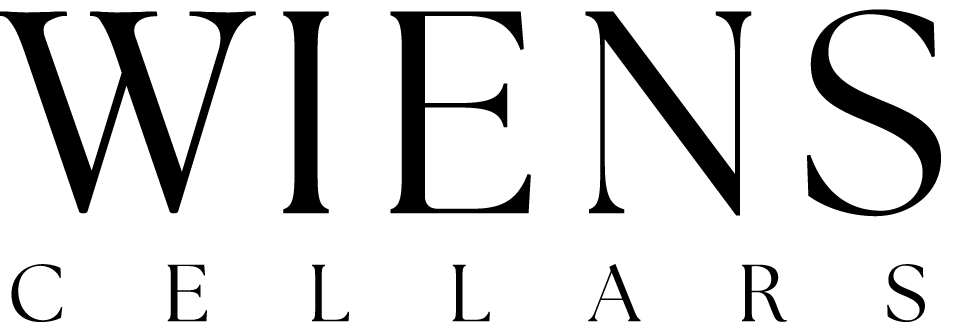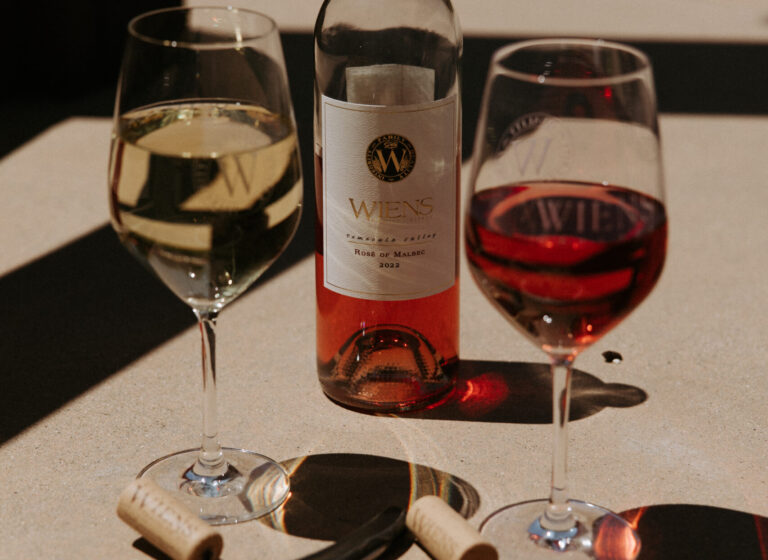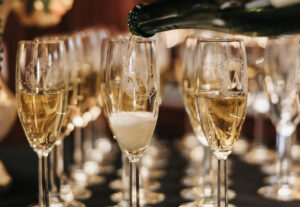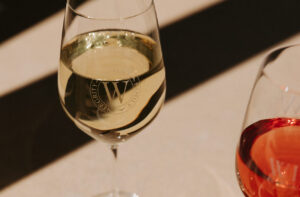Picture this: you’re about to enjoy a glass of your favorite wine. You might not think much about the glass you’re pouring it into, but did you know that glass could be the unsung hero (or villain) of your wine tasting experience? The shape of a wine glass isn’t just about sophistication or aesthetics; it’s a meticulously designed tool that can elevate the wine’s flavors, aromas, and overall enjoyment.
From enhancing the bouquet to influencing the wine’s contact with your palate, the right glass can turn a simple drink into a symphony of sensory delights. It’s fascinating how a vessel, so seemingly simple, holds the power to unlock deeper dimensions of wine, making the exploration of glass shapes a crucial chapter in the wine lover’s journey.
The Anatomy of a Wine Glass: Parts and Functions
- The Bowl: The bowl is the main body of the glass where the wine resides. Its shape and size are critical, as they influence the wine’s exposure to air (aeration) and concentrate the aromas towards the top. Larger bowls are suited for red wines, allowing them to breathe and develop a richer bouquet, while narrower bowls are perfect for whites, preserving their delicate aromas.
- The Stem: Acting as the handle of the wine glass, the stem serves several important functions. It allows you to hold the glass without warming the wine with your body heat, maintaining the wine’s optimal temperature. It also provides a way to swirl the wine, which enhances aeration and aroma release without smudging the bowl with fingerprints.
- The Base: The foundation of the wine glass, the base keeps the glass stable and upright. It’s designed to be sturdy enough to support the glass when filled with wine and during swirling. The base’s size and weight can vary, contributing to the glass’s overall balance and feel.
- The Rim: The rim of the wine glass might seem like a simple edge, but its thickness plays a significant role in the tasting experience. A thinner rim is less obtrusive, making the wine flow more smoothly onto your tongue, enhancing the drinking experience. Some glasses have a slightly tapered rim, directing the flow of wine and focusing the aromas.
Materials Used in Wine Glass Production
- Soda-Lime Glass: The most common material used in glassware, soda-lime glass is durable and cost-effective, making it a popular choice for everyday wine glasses. However, it’s typically thicker and less refined than crystal, which can slightly detract from the wine tasting experience.
- Crystal: Crystal is prized for its clarity and brilliance, making it a favorite for premium wine glasses. It can be made thinner than soda-lime glass, which enhances the wine’s appearance and flavor perception. Crystal often contains lead (though lead-free options are available), which adds to its weight and refractive qualities.
- Lead-Free Crystal: As concerns about lead exposure have grown, lead-free crystal options have become more popular. These glasses are made with substitutes like magnesium or zinc, maintaining the clarity and elegance of traditional crystal without the health risks associated with lead.
- Borosilicate Glass: Known for its durability and resistance to thermal shock, borosilicate glass is a high-quality material used in some wine glasses. It’s lightweight and can withstand temperature changes, making it ideal for both chilled and room-temperature wines.
- Glass Treatments and Coatings: Some wine glasses undergo special treatments or coatings to enhance their durability, clarity, or cleaning ease. These can include hardening processes to prevent scratching or coatings to repel water spots and fingerprints, ensuring that the glass maintains its pristine appearance over time.
Understanding the anatomy of a wine glass and the materials used in its production can greatly enhance your appreciation of wine. Each part of the glass serves a specific purpose, from preserving the wine’s aroma and temperature to enhancing the overall tasting experience. The choice of material further refines this experience, adding elements of clarity, weight, and durability. Whether you’re a casual wine drinker or a connoisseur, recognizing these nuances can elevate your next wine tasting to new heights.
Glass Shapes for Every Wine: A Tailored Experience
The diversity in wine glass shapes isn’t just for show; it’s a reflection of the diversity within wine itself. Red wines flourish in glasses with ample bowls to aerate and develop their complex aromas, while whites thrive in slightly narrower glasses to concentrate delicate floral and fruit notes. Sparkling wines and champagnes sparkle brightest in flutes that celebrate their effervescence, and dessert wines find their sweet spot in smaller glasses to accentuate richness and sweetness.
Behind each design is a world of science aimed at optimizing the wine’s path through your senses. The contours of a glass can direct wine to the tip of your tongue to accentuate sweetness, to the sides for acidity, or to the back for bitterness, transforming your perception of the same wine in different glasses.
The Aroma Orchestra: Conducted by Glassware
Aroma plays a starring role in the wine tasting experience, and the shape of your glass is the conductor. A well-designed glass captures and directs the wine’s aromas to your nose, enhancing the bouquet and, by extension, the flavor. The wider the bowl, the greater the surface area of the wine, allowing more ethanol to evaporate and aromas to rise.
But it’s not just about size; it’s about shape. Certain glasses are designed to narrow at the top, focusing the aromas and making each sniff a deeper dive into the wine’s story. It’s a beautiful reminder that in wine tasting, our noses are as important as our palates.
Texture and Palate: Shaped by Glass
The journey of wine from glass to palate is a ballet of physics and sensory perception. The rim’s width, the bowl’s shape, and the glass’s tilt all influence how wine flows onto your palate, affecting the distribution of flavors and the overall texture. A glass that delivers wine directly to the center of your tongue might emphasize boldness and balance, while a glass that spreads wine across the sides can highlight acidity or sweetness.
This interaction between glass and palate plays a crucial role in how we perceive a wine’s body, tannins, and acidity. It’s a dance of liquid and senses, choreographed by the shape of your glass, revealing layers of complexity with each sip.
Temperature and Time: The Thermic Effect
The shape of a wine glass can also influence the wine’s temperature – a crucial aspect of tasting. A broader bowl allows for more heat transfer from the hand to the wine, ideal for reds which benefit from a slight warmth. Conversely, narrower glasses minimize this effect, keeping whites and sparklings cool and refreshing.
Serving wine at the right temperature is an art in itself, and glassware plays a supporting role, ensuring that each varietal is enjoyed in its ideal state. It’s a reminder that in the world of wine, details matter, and even the warmth of your hand can become part of the experience.
Glassware Psychology: Seeing Wine Through the Glass
Believe it or not, our enjoyment of wine starts with our eyes, and the glassware we use can influence our perceptions and expectations. A beautifully designed glass not only enhances the visual appeal of the wine but can also make it taste better. This psychological effect, where aesthetics blend with sensory experience, adds another layer to the art of wine tasting.
The elegance, weight, and balance of a glass contribute to the overall enjoyment, shaping not just the wine but our mood and our moment. It’s a testament to the power of perception and the role of glassware in elevating the wine experience beyond taste to something truly memorable.
Innovations on the Horizon: The Future in Your Hand
As our understanding of wine evolves, so does glassware design, with innovations aiming to enhance every aspect of wine tasting. From glasses tailored to specific varietals to those using cutting-edge materials to improve durability and clarity, the future of wine glasses is as dynamic as the wines they’re designed to hold.
Custom glasses, designed for unique wine experiences, and technological advancements that refine the tasting process, show that the world of wine glassware is not just about tradition but about innovation, constantly seeking new ways to unlock the full potential of every bottle.
Guidelines for Selecting Wine Glasses
- Consider the Wines You Love: Start by thinking about the types of wine you drink most frequently. If you’re a fan of bold reds, look for glasses with a larger bowl to allow the wine to breathe and release its complex aromas. White wine enthusiasts should lean towards glasses with narrower bowls to concentrate the wine’s delicate fragrances. Sparkling wine aficionados? Flutes or tulip-shaped glasses preserve those precious bubbles.
- Focus on Versatility: If you prefer a minimalist approach or simply want to maximize value, opt for a set of versatile wine glasses. A medium-sized, tulip-shaped glass can serve a wide range of wines decently well, from crisp whites to robust reds, making it a practical choice for those looking to streamline their glassware collection.
- Evaluate the Glass Quality: Look for glasses with a fine rim and enough clarity to appreciate the wine’s color. Crystal, especially lead-free options, offers superior clarity and a satisfying thinness at the rim but can be pricier. High-quality glass can be a more affordable alternative, offering durability without sacrificing too much on the sensory experience.
Balancing Functionality, Aesthetics, and Budget
- Functionality First: The primary role of a wine glass is to enhance the wine’s aroma and flavor. A beautifully designed glass that falls short in this regard misses the mark. When selecting glassware, consider how its shape and size will affect your wine. For instance, a well-designed stem not only adds elegance but also keeps the wine at the correct temperature by minimizing hand contact.
- Aesthetic Appeal: A wine glass should be a feast for the eyes as well as the palate. The right glassware complements the visual experience of wine tasting, adding an element of sophistication and pleasure. Consider the style of your dining ware and home when selecting glassware. Whether you prefer sleek, modern designs or traditional, ornate glasses, your choice should reflect your personal style and enhance the overall dining experience.
- Mindful of the Budget: While it’s tempting to splurge on premium crystal for its brilliance and finesse, it’s essential to consider your budget. Remember, a more expensive glass does not automatically guarantee a better wine tasting experience. Many high-quality, lead-free crystal and glass options offer excellent functionality and aesthetics without breaking the bank. It’s about finding the best value—glassware that meets your wine needs, matches your taste, and fits your budget.
- Invest Wisely: Consider your wine glass purchase an investment in your wine drinking experience. It might be worth spending a little more on glasses that will enhance your favorite wines’ aroma and taste. However, always weigh the cost against how often you’ll use them and their care requirements. For those who entertain frequently or enjoy a variety of wines, investing in specific glasses for different types of wine might enhance the experience for you and your guests.
In the end, choosing the right wine glass is about enhancing your enjoyment of wine. By considering the types of wine you drink, focusing on versatility, and balancing functionality with aesthetics and budget, you can select glassware that elevates every wine experience. Remember, the best wine glass is one that brings you joy in use, complements your lifestyle, and makes each sip of wine a moment to savor.
The Endless Journey of Discovery
The exploration of wine glass shapes and their effects on flavor is a fascinating chapter in the broader story of wine. It’s a journey that invites experimentation, encouraging wine enthusiasts to play, to test, and to discover firsthand how different glasses can transform their wine experience.
As we continue to delve into the science and art of wine tasting, let’s not forget the joy of exploration, the thrill of discovery, and the endless possibilities that await in every glass. The world of wine is vast and varied, and with the right glass in hand, every sip can be a new adventure. So raise your glass – here’s to the journey, the science, the art, and the sheer delight of wine.




